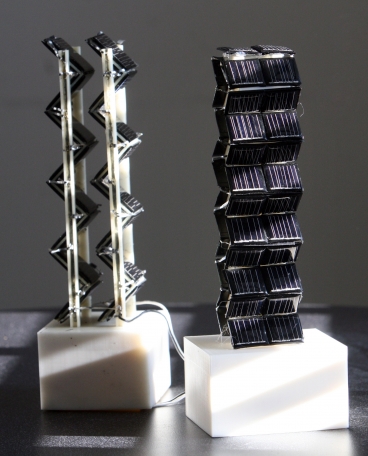Researchers from the Massachusetts Institute of Technology (MIT) have discovered a new approach that enhances the performance of solar cells through three-dimensional (3D) configurations.
 Two small-scale versions of three-dimensional photovoltaic arrays were among those tested by Jeffrey Grossman and his team on an MIT rooftop to measure their actual electrical output throughout the day.
Two small-scale versions of three-dimensional photovoltaic arrays were among those tested by Jeffrey Grossman and his team on an MIT rooftop to measure their actual electrical output throughout the day.
Testing on 3D structures such as towers or cubes has revealed a higher power output than the fixed flat panels. In order to analyze a wide range of possible cell configurations, MIT researchers have used a computer algorithm. They also developed an analytic software to test any arrangement under various weather conditions, seasons and latitudes. Then, finally the team constructed and tested 3D modules on the roof of an MIT’s lab.
The energy cost of the 3D modules was found to be greater than the traditional flat panels. However, the cost is partially balanced by a higher power output for a specified base area and by the production of uniform output during blockage from shadows or clouds, all through the day and year. These enhancements can enable easier integration of 3D photovoltaic systems with the power grid when compared to conventional systems. The vertical surfaces of the 3D solar systems have an ability to collect a higher amount of sunlight during winter months, mornings and evenings. This is the major reason for enhanced power output and production of more uniform energy over time.
An associate professor of power engineering at MIT, Jeffrey Grossman noted that the solar cells are now less expensive when compared to installation, wiring and support structures. Hence, the benefits of the 3D structures will increase depending on the costs.
MIT team’s computer modelling has revealed that only complex shapes such as cubes can produce an enormous improvement in power output, however manufacturing these shapes is quite difficult. The shapes can be simplified with minimum energy loss through the algorithms. Hence, the team tested both complex and simpler accordion-like towers on their rooftop tests.
At present, MIT researchers have designed individual 3D solar modules and have planned to explore a group of such towers. The 3D systems can offer a huge benefit in space-constrained sites and can also be utilized in large-scale applications like solar farms. However, mass production of such solar shapes in a cost-effective manner remains a major challenge.